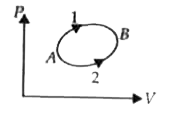A thermodynamic system is taken from an initial state I with internal energy to the final state f along two different paths iaf and ibf, as schematically shown in the figure. The work done by the system along the pat af, ib and bf are respectively. The heat supplied to the system along the path iaf, ib and bf are respectively. If the internal energy of the system in the state b is , The ratio is

The correct Answer is:B
Here,
Now,
and
Topper's Solved these Questions
- THERMODYNAMICSBOOK - PRADEEPCHAPTER - THERMODYNAMICSEXERCISE - Assertion- Reason Type Questions
19 Videos
- THERMODYNAMICSBOOK - PRADEEPCHAPTER - THERMODYNAMICSEXERCISE - Multiple choice questions.
96 Videos
- SYSTEMS OF PARTICLES AND ROTATIONAL MOTIONBOOK - PRADEEPCHAPTER - SYSTEMS OF PARTICLES AND ROTATIONAL MOTIONEXERCISE - Assertion- Reason Type questions
20 Videos
- WORK, ENERGY AND POWERBOOK - PRADEEPCHAPTER - WORK, ENERGY AND POWEREXERCISE - Assertion-Reason Type Questions
24 Videos
Similar Questions
A thermodynamic system is taken from an initial state I with internal energy Ui=100J to the final state f along two different paths iaf and ibf, as schematicallly shown in the figure. The work donw by the system along the paths af, ib and bf are Waf=200J,Wib=50J and Wbf=100J respectively.the heat supplied to the system along the path iaf, ib and bf are QiafQ(jb) and Qbf repsectively.If the internal energy of the system in the state b is Ub=200J and Qiaf=500J, the ratio Qbf/Qjbis

In the figure a container is shown to have a movable(without friction) piston on top. The container and the piston are all made of perfectly insualting material allowing no heat transfer between outside and inside the container The container is divided int to two compartments by a rigid partition made of a themally conducting material that allows slow tranfer of heat.The lower compartment of the container is filled with 2 moles of an ideal monatiomic gas at 700K and the upper compartment is filled with 2 moles of an ideal diatomic gas at 400 K.The heat capacitites per mole of na ideal monatomic gas are Cv=32R,Cp=52r, and those for an ideal diatomic gas are Cv=52r,cp=72R.
View SolutionA system is taken from state A to state B along two different paths 1 and 2 . The heat absorbed and work done by the system along these two paths are Q1 and W1 and W2 respectively.
View Solution
Knowledge Check
A system is taken from state A to state N along two different paths 1 and 2. The heat absorbed and work done by system along these two paths are Q1 and Q2, and W1 and W2 respectively. Then
AQ1=Q2BW1=W2CQ1−W1=Q2−W2DQ1+W1=Q2+W2For a gaseous state if heat supplied to the system is 100 J and work done by the system is 25 J. then internal energy of the system is
A125 JB100 JC50 JD75 JA system goes from P to Q by two different paths in the P-V diagram as shown in figure. Heat given to the system in path 1 is 1100 J, the work done by the system along path 1 is more than path 2 by 150 J. The heat exchanged by the system in path 2 is
 A800 JB750 JC1050 JD950 J
A800 JB750 JC1050 JD950 J
A system is taken from state "A" to state "B" along two different paths,"1" and "2." The heat absorbed and work done by the system along these two paths are Q1 and Q2 and W1 and W2 respectively
View SolutionA system goes from P to Q by two different paths in the p−V diagram as shown in figure. Heat given to the system in path 1 is 1000 J. The work done by the system along path 1 is more than path 2 by 100 J. What is the heat exchanged by the system in path 2 ?

View SolutionA system goes from P to Q by two different paths in the P−V diagram as shown in (figure). Heat given to the system in path 1 is 1000J. The work done by the system along path 1 is more than path 2 by 100J. What is the exchange by the system in path 2?

View SolutionA system suffers an increase in internal energy of 80J and at the same time has 50J of work done on it. What is the heat change of the system?
View SolutionA system goes from A to B by two different paths in the P-V diagram as shown in figure Heat given to the system in path 1 is 1100 j, the work done by the system along path 1 is more than path 2 by 150 J. The heat exchanged by the system in path 2 is

View Solution
